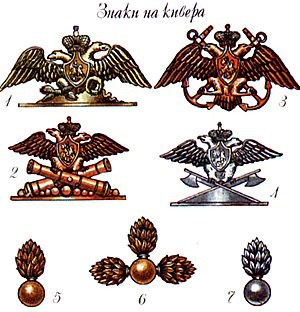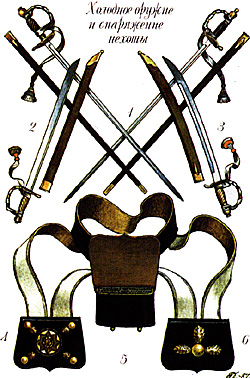Questions and Answers
Russian Shako Badges 1812
by Charles C. Sharp
| |
The EE&L Staff will be happy to answer questions and share your comments or answers on uniforms, tactics, and other subjects. The following question, after partial answers in EE&L #5 and #6, has been complemented by Mr. Charles C. Sharp. We are sure that the readership will appreciate the color plates. RUSSIAN SHAKO BADGES - 1812Question 5-1 in EE&L #5 asked if the shako and cartridge pouch badges of the Russian "fusilier" in 1812 had single or triple flames. The Staff answer was incomplete, so the following will, I hope, clarify and expand on their response. Illustration I "Znaki na kivera" ("Badges on Shakos") is from a Russian series of illustrated cards on the army of the "Patriotic War of 1812." The badges illustrated are identified as follows: 1. Gilded shako badge of the Guards Regiments Preobrazhenskii, Semenovskii, lzmailovskii, Guards Egerskii and Finlandskii, with the shield of St. George, adopted April 16, 1808. The Life Guard Hussars wore a similar shako badge, while that of the Litovskii (Lithuanian) Guard Regiment had a Lithuanian knight in place of the figure of St.George on the shield. 2. Shako badge of the Guard Artillery with crossed cannons in brass. 3. Shako badge on the Guard Sailors ("Equipage") Battalion formed on February 16, 1812, with crossed anchors in place of the guns, also in brass. 4. Shako badge of the Life Guard Sapper Battalion, formed December 27, 1812: Guard pattern in silver with crossed axes. 5. Brass shako badge of the infantry and jager regiments: "Grenadki ob adnom Ogne" ("Grenade with one flame"). 6. Grenadier Regiments wore a brass shako badge of a grenade "A trekh ognyakh ("with three flames"). This pattern was also worn by the elite companies of the regular infantry or jager regiments. In addition, the officers and men of the miner companies of the 1st and 2nd Pioneer Regiments wore the same pattern in white metal. 7. Shako badge of the officers and engineers of the Pioneer Companies: same pattern as No. 5, but in white metal. Additional note: The (line) artillery wore an infantry style shako badge (one flame) with crossed cannons above it. Illustration 2 "Kholodnoe Oruzhie i Snaryazhenie Pekhoty" (side arms and Cartridge Pouches of the inf I antry") shows at the bottom, the cartridge pouch badges. On the pouch flap were badges in brass (white metal for pioneers) which "Varied according to the norm and type of forces." For example: 4. Cartridge pouch and badge of the Guard "heavy" infantry (non-jagers) with the star of St. Andrew and four grenades in brass. 6. A Grenadier's pouch with the grenade emblem with three flames. Army jager regiments (not shown) wore their regimental number in brass on the pouch flap. In another illustration from this series of cards, a private of the pioneers is shown with a cartridge pouch with , white metal emblem with one flame. B) implication, though not shown, the regular infantry had a single flame grenade in brass on their pouch flaps Garrison regiments and militia infantry ("Opoichenie") had no emblem at all or their pouch. One possible source of confusion and variation from the "official" decoration of both shakos and pouches is that unit,, which were converted from one type to another may have had considerable delay in getting new badges. Thus, the fourteen line regiments that converted to jagers in 1810, or the Garrison regiments that were raised to line status in 1811, or the Rostov Line Infantry that converted to the Arakcheev Grenadiers Regiment in 1811, may all have some or all of their old badges displayed in 1812. The units so affected were: (1) Jager Regiments converted from Line units in October 1810: 33rd through 47th, and 47th and 48th Jager Regiments formed from 5th and 7th Garrison Regiments respectively in January 1811. (2) 49th Jager Regiment formed from 8th Garrison Regiment in January 1811. converted to Sofia Infantry Regiment in March, was re-raised in October 1811, along with 50th Jager Regiment. (3) Infantry Regiments raised in 1811 from Garrison Regiments: Lithuania, Podolsk, Voronezh, Galitz, Bryansk, Estonia, Velikilustsk, Penza, and Saratov. Any of the above units could have soldiers in the ranks in 1812 that still had the older pouch and shako badges, or, in the case of units raised from Garrison units, had no emblems on the pouches at all. Summarizing, the ordinary "fusilier" in the infantry regiment would have a single- flame grenade on both his shako and cartridge pouch, but the members of the elite companies of the same regiment would wear a "three flame" grenade emblem. If the infantry regiment had been formed recently from a garrison regiment, some or most of the men might not yet have received any pouch or shako badges. 
Back to Empire, Eagles, & Lions Table of Contents Vol. 2 No. 7 Back to EEL List of Issues Back to MagWeb Master Magazine List © Copyright 1994 by Emperor's Headquarters This article appears in MagWeb (Magazine Web) on the Internet World Wide Web. Other military history articles and gaming articles are available at http://www.magweb.com |

